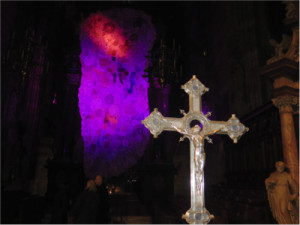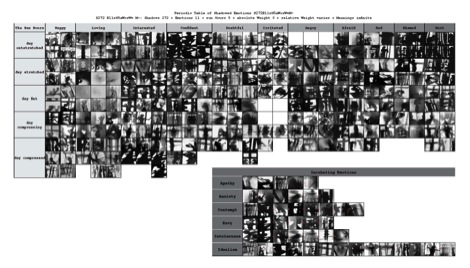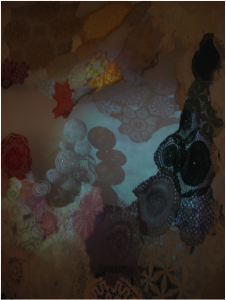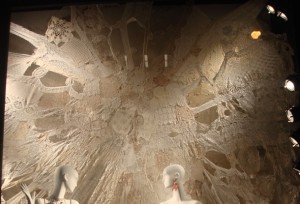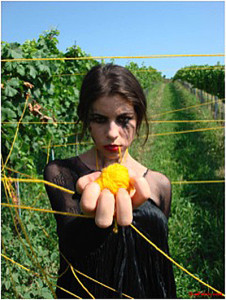Reviewing the Photographic Insight of Eva Petric
Return to Issue Table of Content / Return to the Series Table of content
Dan Duda and Eva Petric collaborated on the creation of this essay. Eva Petric is a visual artist working out of Vienna, Austria and Dan Duda is a scientific writer living in Lititz, Pennsylvania (USA). This is Dan’s fourth essay for VJIC on photography and Quantum theory. Eva Petric visual dialog is linked from this essay.
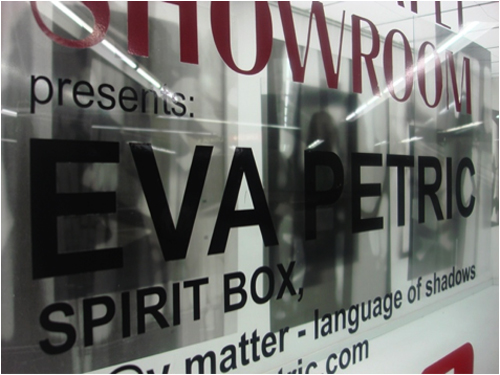
© Eva Petric: A glimpse into Spirit Box installation at Karlsplatz Showroom, Nov. 2014, Viennna, Austria
Think about time. It’s consistent, right? Time passes at the same rate whether you’re sitting in your office; driving across town; or, flying across the continent—right? WRONG! Einstein’s General Theory of Relativity proved that time is flexible. It bends in gravity. It flows at a different pace for people moving relative to one another. And it would stop completely for any object reaching the speed of light (if that were possible). But wait, there’s more—even the sequence of events can be different for people moving relative to one another. Stranger than that, time is really a fabric that includes space. It’s called the space-time continuum. All these facts have been verified, over and over, by science—but do we really understand them? Do we really understand anything?
“For a hypothetically supersensible being, there would be no ‘flowing’ of time: the universe would be a single block of past, present, and future. But due to the limitations of our consciousness we perceive only a blurred vision of the world and live in time.” [Carlo Rovelli, Italian Theoretical Physicist)
There’s a bridge on the path to true awareness that we humans seem unable to cross. And artists like Eva Petric help us cross that bridge. According to Caltech physicist Sen Carroll “A hundred years ago we knew nothing correct about the large scale structure of the universe. We didn’t even know there were other galaxies.” In my humble opinion, a hundred years from now someone will look back and say the same thing about our understanding in 2016— ‘they knew basically nothing back then.’
There are three primary ways we have of attempting to come to grips with reality: they are science; religion and art. As demonstrated by Einstein, science is constantly changing because the pursuit of truth is not the acquisition of truth, and true science is constantly changing because it is a never ending search. Since ultimate reality is beyond the paltry reach of our limited senses, religion employs “faith”—an acceptance of dogmatic notions of the ineffable reality that we’re part of. Einstein considered this dilemma, he asked “How can cosmic religious feeling be communicated from one person to another, if it can give rise to no definite notion of a God and no theology? In my view, it is the most important function of art and science to awaken this feeling and keep it alive in those who are capable of it.”
Many eastern religions advocate bypassing the five senses and connecting directly to the ‘ultimate’ through meditation. The human condition, in their view, is one of confusion caused by “duality.” As soon as we give something a name we unwittingly accept the idea that it is something separate from us. And it’s where our ability to fathom reality falls of the track, because, in their view the whole universe and everything in it is really just one thing.
Max Planck. Art is a way of expressing perceptions that cannot be communicated with words. It supersedes logic and forges a connection with realities that are beyond a human’s limited ability to reason. The work of Eva Petric is a powerful expression of this process. Let’s start with the grandfather of quantum mechanics, Max Planck.
Through his experiments with black body radiation, Planck was mystified that nature didn’t behave the way science thought it should. Instead of a continuous advance in emitted radiation when heated, a discrete series of steps was observed. The energy was emitted in packets, or “quanta.” Now scientists have found that reality itself presents in quantum form—time, space and matter exist in boxes, not in continuous streams. Eva Petric captures the essence of quantized reality in many of her images.
Erwin Schrödinger.
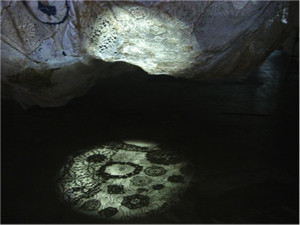
IN between SPACE, Burgkapelle, Museum for Modern Art © Eva PetricCarinthia, Klagenfurt, Austria, April 5 – August 31 2014.
A relatively famous thought experiment is called Schrodinger’s Cat. His idea was based on the strange results of detailed experiments which indicate that there is no reality unless someone is there to perceive it. Briefly stated, Schrodinger posited that if Quantum Mechanics is correct, a cat, locked in a box with time delayed poison would be both dead and alive until someone opened the box to look. Several of Eva’s images capture the feeling of this bizarre yet scientifically accepted feature of the universe we live in.
Werner Heisenberg.
Although we live our lives with the acceptance of what we believe to be certain truths, at a fundamental level the universe is a random laboratory. Heisenberg’s Uncertainty Principle proved, through repeated experiment, that you actually can do the same thing over and over and get different results. Einstein blasted this idea in a protracted debate with the Quantum Science establishment in the early 1900s (the Einstein-Bohr debate). He said “I like to think the Moon is there even if I’m not looking at it.” It’s the one debate Einstein lost. Further, we have absolutely no idea what a particle is doing between human observations—or even if it exists at all. Quantum mathematics is based on statistical analysis. It has been 100% accurate in every prediction it makes—but on a statistical basis. Science cannot predict however how any individual particle will behave.
So what do we know?
Every time I learn about breakthroughs in our understanding of reality I’m reminded of Sergeant Schultz from the sitcom Hogan’s Heroes. His famous line was “nothing. I know nothing.” And as much as I love science, that seems to be the reality of our situation. According to Sen Carroll “A hundred years ago we knew nothing correct about the large scale structure of the universe. We didn’t even know there were other galaxies.” In my humble opinion, a hundred years from now someone will look back and say the same thing about our understanding— ‘they knew basically nothing back then.’ But there are bright spots for those of us who are passionate about pursuing this Camusian quest. Science provides a continuous stream of persuasive ideas and information. And artists, like Eva Petric, create beautiful and compelling images to help in our meditations about our ineffable reality.
In the immortal words of Isaac Newton “I was like a boy playing on the sea-shore, and diverting myself now and then finding a smoother pebble or a prettier shell than ordinary, whilst the great ocean of truth lay all undiscovered before me.”

